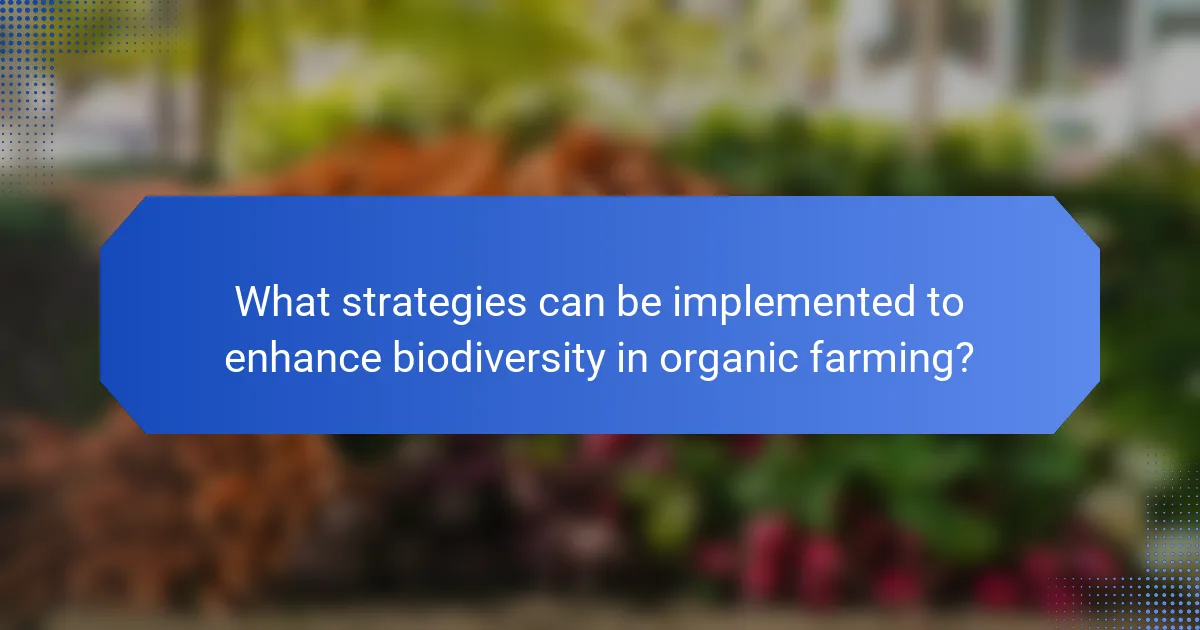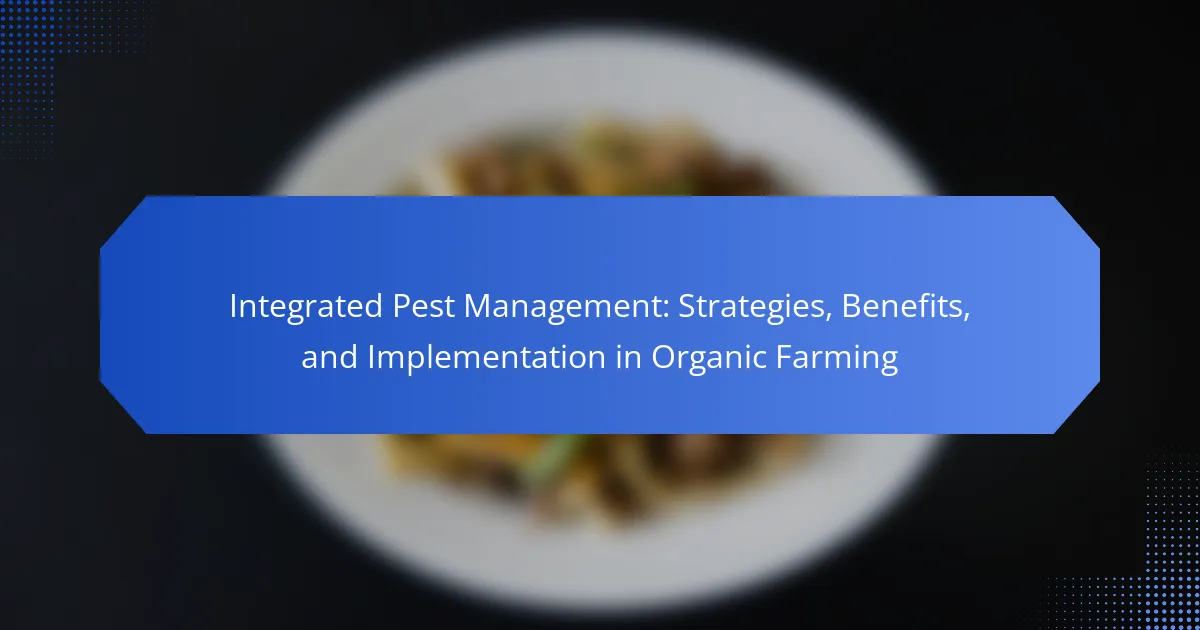Biodiversity in organic farming refers to the variety of life forms, including plants, animals, and microorganisms, within agricultural ecosystems. This article explores the importance and benefits of biodiversity in organic farming, highlighting how practices such as crop rotation, cover crops, agroforestry, and the establishment of buffer zones can enhance ecosystem health and resilience. It discusses the role of natural pest control and the avoidance of synthetic chemicals in supporting biodiversity. Additionally, the article outlines methods for farmers to measure and monitor biodiversity, including species inventories, biodiversity indices, and remote sensing technology, emphasizing the connection between biodiversity and improved agricultural productivity.

What is Biodiversity in Organic Farming?
Biodiversity in organic farming refers to the variety of life forms and ecosystems present in agricultural systems. It encompasses the diversity of plants, animals, microorganisms, and their interactions. Organic farming practices promote biodiversity by avoiding synthetic chemicals and fostering natural ecosystems. This approach enhances soil health and pest control. A diverse farming system can improve resilience against diseases and climate change. Studies show that farms with higher biodiversity yield better ecological benefits. For instance, a report by the Food and Agriculture Organization highlights that biodiversity supports pollination and nutrient cycling.
Why is biodiversity crucial for organic farming systems?
Biodiversity is crucial for organic farming systems because it enhances ecosystem resilience and productivity. Diverse species contribute to soil health, pest control, and pollination. Healthy soil supports a variety of microorganisms, which improve nutrient cycling. This leads to better crop yields and sustainability. Moreover, biodiversity helps in natural pest management. A variety of plants can attract beneficial insects that control harmful pests. According to a study by the Food and Agriculture Organization, diverse agroecosystems are more productive and sustainable. This evidence highlights the importance of biodiversity in maintaining organic farming systems.
What are the key components of biodiversity in organic farming?
Key components of biodiversity in organic farming include crop diversity, soil health, and ecosystem interactions. Crop diversity involves growing various plant species to enhance resilience and productivity. Soil health is maintained through organic practices that promote microbial diversity and nutrient cycling. Ecosystem interactions encompass the relationships between plants, animals, and microorganisms that support pollination and pest control. These components contribute to sustainable agricultural practices. Research shows that greater biodiversity improves ecosystem services, such as soil fertility and pest management, leading to more sustainable farming systems.
How does biodiversity contribute to ecosystem resilience?
Biodiversity significantly contributes to ecosystem resilience by enhancing stability and adaptability. Diverse species fulfill various ecological roles, which helps maintain ecosystem functions. For instance, a variety of plants can support different pollinators, ensuring effective reproduction. This diversity allows ecosystems to recover from disturbances, such as climate change or disease outbreaks. Studies show that ecosystems with higher biodiversity are better at withstanding environmental stressors. For example, a meta-analysis published in “Nature” found that biodiversity loss can decrease ecosystem productivity by up to 50%. Thus, preserving biodiversity is crucial for sustaining resilient ecosystems.
What are the benefits of promoting biodiversity in organic farming?
Promoting biodiversity in organic farming enhances ecosystem health and resilience. It supports natural pest control by maintaining predator-prey relationships. Diverse crops improve soil fertility through varied root structures and nutrient uptake. Biodiversity also increases pollinator populations, which are crucial for crop yields. Studies show that farms with higher biodiversity have better pest management and reduced reliance on chemical inputs. Furthermore, diverse ecosystems are more resilient to climate change impacts. This adaptability ensures sustainable food production over time.
How does biodiversity enhance soil health and fertility?
Biodiversity enhances soil health and fertility by promoting a variety of organisms that contribute to nutrient cycling. Diverse plant species improve soil structure and prevent erosion. Microorganisms, such as bacteria and fungi, break down organic matter, releasing essential nutrients. This process increases soil organic carbon content, which is vital for fertility. Additionally, diverse root systems enhance water retention and aeration. Studies show that farms with higher biodiversity yield better crops and have improved soil quality. For example, a study published in the journal “Nature” found that diverse cropping systems lead to a 20% increase in soil fertility. Thus, biodiversity is crucial for sustaining healthy soils in organic farming.
What role does biodiversity play in pest and disease management?
Biodiversity plays a crucial role in pest and disease management by enhancing ecosystem stability and resilience. Diverse ecosystems support a variety of natural predators and parasitoids that help control pest populations. For instance, studies show that higher plant diversity can lead to increased populations of beneficial insects, which reduce pest outbreaks. Additionally, genetic diversity within crops can improve resistance to diseases. Research indicates that polycultures can outperform monocultures in pest suppression, providing a more balanced ecosystem. Thus, promoting biodiversity is essential for sustainable pest and disease management in organic farming.
How can biodiversity improve crop yields and quality?
Biodiversity can significantly improve crop yields and quality. Diverse ecosystems enhance soil health and fertility. Healthy soil supports greater plant growth. Biodiversity also promotes natural pest control. Various species can deter harmful insects and diseases. This reduces the need for chemical pesticides. Additionally, diverse plant varieties can improve resilience to climate change. Crop diversity can lead to higher nutritional value. Research shows that farms with higher biodiversity yield up to 20% more. This evidence supports the positive impact of biodiversity on agriculture.

What strategies can be implemented to enhance biodiversity in organic farming?
Implementing crop rotation is a key strategy to enhance biodiversity in organic farming. This practice involves alternating the types of crops grown in a specific area across seasons. It helps prevent soil depletion and reduces pest and disease cycles.
Utilizing cover crops is another effective method. Cover crops protect soil from erosion and enhance soil fertility. They also provide habitat for beneficial insects and microorganisms.
Integrating agroforestry systems can further promote biodiversity. This approach combines agriculture with tree planting. It creates diverse ecosystems that support various species and improve overall farm resilience.
Establishing buffer zones around fields is beneficial as well. These areas can host native plants that attract pollinators and beneficial predators. They help to create a more balanced ecosystem.
Encouraging natural pest control by promoting predatory insects is also crucial. This can be achieved by planting diverse crops that attract these beneficial species.
Finally, maintaining organic practices is fundamental. Organic farming avoids synthetic chemicals, which can harm biodiversity. By focusing on natural methods, organic farms support a wider range of species.
These strategies collectively contribute to a healthier ecosystem and improved productivity in organic farming.
How can farmers increase plant diversity on their farms?
Farmers can increase plant diversity on their farms by implementing crop rotation. This practice involves alternating the types of crops grown in a specific area each season. Crop rotation helps improve soil health and reduces pest and disease cycles. Additionally, farmers can introduce cover crops, which provide ground cover and enhance soil nutrients. Intercropping, or planting different crops in close proximity, also promotes biodiversity. Utilizing native plant species can attract beneficial insects and pollinators. According to a study by the USDA, diverse cropping systems can lead to increased yields and resilience against climate change. These strategies contribute to a more sustainable farming ecosystem.
What are the best practices for intercropping and crop rotation?
Best practices for intercropping include selecting complementary crops that enhance each other’s growth. For example, planting legumes with cereals improves nitrogen fixation. Crop rotation best practices involve alternating different crop families to disrupt pest cycles. This method reduces soil nutrient depletion and improves soil health. Additionally, timing is crucial; crops should be rotated based on their growth cycles. Implementing cover crops during off-seasons can prevent soil erosion and enhance organic matter. Research shows that diverse cropping systems increase resilience against pests and diseases, promoting sustainable agriculture.
How can cover crops contribute to biodiversity?
Cover crops contribute to biodiversity by providing habitat and food for various organisms. They enhance soil health, which supports diverse microbial communities. Cover crops can attract beneficial insects, such as pollinators and natural pest predators. Diverse plant species in cover crops can improve ecosystem resilience. Research shows that fields with cover crops have increased species richness. This diversity can lead to better pest control and improved crop yields. Studies indicate that cover crops can also reduce erosion and nutrient runoff. Overall, cover crops play a crucial role in promoting agricultural biodiversity.
What role do livestock and animals play in promoting biodiversity?
Livestock and animals play a crucial role in promoting biodiversity. They contribute to the maintenance of diverse ecosystems through various activities. Grazing animals help manage vegetation, preventing the dominance of certain plant species. This grazing behavior encourages a variety of plant growth, which supports different animal species. Additionally, livestock manure enriches soil fertility, promoting a wider range of microbial life. Diverse microbial communities enhance soil health, which is vital for plant diversity. Furthermore, integrated livestock systems can improve habitat quality for native wildlife. Studies show that farms with livestock often have higher species richness compared to those without. This highlights the positive impact of livestock on overall biodiversity in agricultural landscapes.
How can integrated livestock systems benefit biodiversity?
Integrated livestock systems can benefit biodiversity by promoting diverse ecosystems and enhancing soil health. These systems incorporate various animal species alongside crops, which leads to increased habitat variety. This habitat supports a wider range of plant and animal species. Additionally, livestock manure enriches soil fertility, fostering microbial diversity. Research shows that farms with integrated systems often have higher species richness compared to monoculture farms. A study from the University of Reading found that integrated systems can improve pollinator populations, crucial for crop production. Thus, integrated livestock systems create a more resilient agricultural environment.
What are the advantages of agroforestry in organic farming?
Agroforestry enhances organic farming by promoting biodiversity, improving soil health, and increasing crop yields. The integration of trees and shrubs with crops fosters a diverse ecosystem. This diversity attracts beneficial insects and pollinators, which are crucial for crop production. Agroforestry systems also improve soil structure and fertility through organic matter from leaf litter and root systems. Research shows that agroforestry can increase crop yields by up to 30% compared to conventional farming practices. Additionally, agroforestry systems can reduce erosion and enhance water retention in the soil. This leads to more sustainable and resilient farming practices.

How can farmers measure and monitor biodiversity in their practices?
Farmers can measure and monitor biodiversity through various methods. They can use species inventories to catalog plants and animals on their land. This helps in understanding the variety of life present. Farmers can also implement biodiversity indices to quantify species richness and evenness. These indices provide a numerical representation of biodiversity levels. Additionally, remote sensing technology can track changes in land cover and habitat types. This technology offers insights into ecosystem health over time. Regular soil assessments can reveal microbial diversity, which is crucial for soil health. Monitoring these aspects allows farmers to adapt practices for better biodiversity outcomes.
What tools and methods are available for assessing biodiversity?
Tools and methods for assessing biodiversity include field surveys, remote sensing, and genetic analysis. Field surveys involve direct observation and sampling of species within an ecosystem. This method provides detailed data on species richness and abundance. Remote sensing uses satellite imagery to analyze land cover and habitat types. It offers a broad perspective on biodiversity patterns over large areas. Genetic analysis assesses the genetic diversity within species. This method helps in understanding population dynamics and evolutionary processes. Additionally, biodiversity indices, such as the Shannon-Wiener Index, quantify species diversity. These tools and methods are essential for effective biodiversity monitoring and management.
How can farmers use biodiversity indicators to track progress?
Farmers can use biodiversity indicators to track progress by measuring species diversity and ecosystem health. These indicators can include the variety of crops, presence of beneficial insects, and soil microbial diversity. Monitoring these factors helps assess the effectiveness of organic farming practices. For example, a study by the Food and Agriculture Organization found that higher plant diversity leads to improved pest control. Farmers can also use specific metrics, such as the Shannon Index, to quantify biodiversity levels. Regular assessments can inform management decisions and enhance sustainability. Ultimately, tracking these indicators supports better resource management and ecological balance.
What role does technology play in biodiversity monitoring?
Technology plays a crucial role in biodiversity monitoring by enabling precise data collection and analysis. It utilizes tools like remote sensing, drones, and camera traps. These technologies help track species populations and habitat changes. For instance, satellite imagery can identify land use changes affecting biodiversity. Drones provide real-time data on hard-to-reach areas. Camera traps capture wildlife activity, offering insights into species behavior. Additionally, mobile applications facilitate citizen science, allowing public participation in data gathering. Research indicates that technology improves monitoring efficiency and accuracy. A study by Pettorelli et al. (2014) highlights how technological advancements enhance conservation efforts.
What are some practical tips for implementing biodiversity strategies in organic farming?
Implementing biodiversity strategies in organic farming can enhance ecosystem health. Start by diversifying crop species to improve resilience. Incorporate cover crops to prevent soil erosion and enhance soil fertility. Use crop rotation to disrupt pest cycles and reduce disease. Create habitats for beneficial insects by planting native flowers and shrubs. Implement integrated pest management to minimize chemical use and promote natural predators. Utilize organic compost to enrich soil biodiversity. Establish buffer zones with native vegetation to protect water quality. Engage in community seed sharing to preserve local varieties and promote genetic diversity.
How can farmers engage with local communities to promote biodiversity?
Farmers can engage with local communities to promote biodiversity by organizing educational workshops. These workshops can teach community members about sustainable farming practices. Farmers can also collaborate with local schools to create programs focused on biodiversity. Such programs can include field trips to farms to observe diverse ecosystems.
Additionally, farmers can establish community gardens that incorporate native plants. These gardens can serve as habitats for local wildlife. Farmers can also participate in local farmers’ markets to share knowledge about biodiversity. By sharing their experiences, farmers can inspire others to adopt biodiversity-friendly practices.
Research shows that community involvement in biodiversity initiatives increases awareness and support. A study by the Food and Agriculture Organization highlights the positive impact of community engagement on local ecosystems.
What resources are available for farmers looking to enhance biodiversity?
Farmers looking to enhance biodiversity can access various resources. These include government programs that promote conservation practices. The USDA provides financial assistance for implementing biodiversity-friendly practices. Non-profit organizations offer educational materials and workshops focused on sustainable farming. Research institutions publish studies on biodiversity benefits and techniques. Online platforms provide tools for monitoring biodiversity on farms. Local agricultural extension services offer personalized advice and support. Additionally, seed banks supply diverse plant varieties that contribute to ecosystem resilience. These resources collectively support farmers in their biodiversity enhancement efforts.
Biodiversity in organic farming refers to the variety of life forms and ecosystems that enhance agricultural systems. This article explores the significance of biodiversity, highlighting its role in improving soil health, pest management, and crop yields while promoting ecosystem resilience. Key components include crop diversity, soil health, and ecosystem interactions, with strategies for implementation such as crop rotation, cover crops, and integrated livestock systems. The article also discusses the importance of monitoring biodiversity through various tools and community engagement to foster sustainable farming practices.



